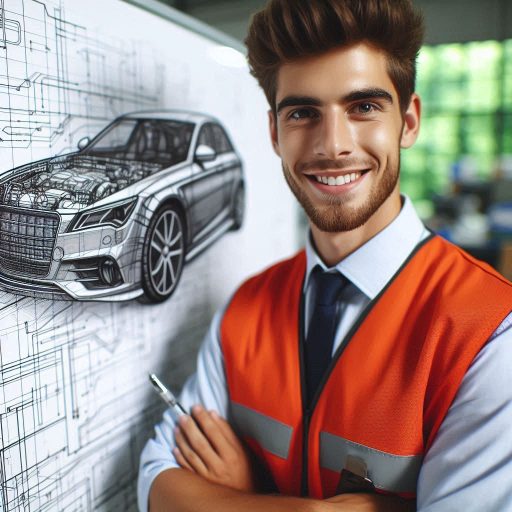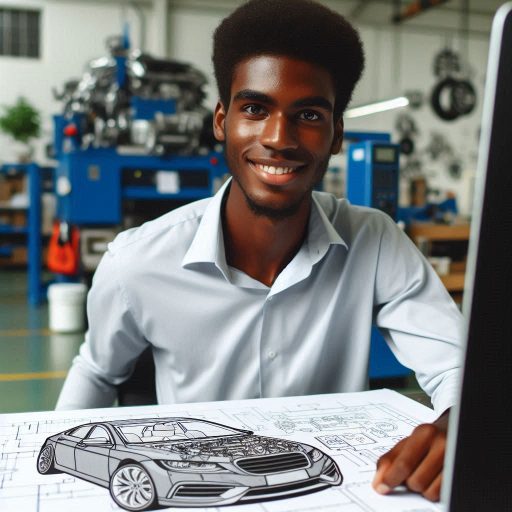Introduction
3D modeling plays a crucial role in automotive design today.
It allows designers to create precise representations of vehicles.
These models help visualize concepts and streamline the design process.
By using 3D modeling, designers can quickly iterate ideas and make informed decisions.
This technology enhances collaboration among teams, ensuring everyone shares a common vision.
The automotive industry is increasingly competitive.
As companies strive to innovate, the need for effective design tools grows.
3D modeling helps designers keep pace with market demands.
It enables the exploration of complex shapes and forms that enhance vehicle aesthetics and functionality.
Through advanced modeling software, designers can simulate various materials and finishes.
This capability significantly improves the accuracy of design presentations.
Furthermore, 3D modeling reduces the time needed for physical prototypes.
This efficiency allows designers to focus on creativity rather than production logistics.
With the ability to test designs virtually, companies save money and resources.
This advantage is especially vital in an industry that prioritizes rapid development cycles.
The demand for skilled 3D modelers is on the rise.
Automotive companies actively seek professionals who can utilize cutting-edge modeling software.
These skills are essential for staying ahead in a fast-evolving market.
As electric and autonomous vehicles emerge, designers must adapt their approaches.
This shift requires expertise in 3D modeling to navigate new design challenges.
Transform Your Career Today
Unlock a personalized career strategy that drives real results. Get tailored advice and a roadmap designed just for you.
Start NowEducational institutions are responding by offering specialized programs.
These programs prepare students for careers in automotive design.
By focusing on 3D modeling, they equip future designers with the necessary tools.
Ultimately, the integration of 3D modeling into automotive design is essential.
It fosters innovation and meets the industry’s growing demand for skilled professionals.
Understanding the Basics of 3D Modeling
What 3D modeling is and how it is used in automotive design
3D modeling creates a digital representation of objects in three dimensions.
Automotive designers use 3D modeling to visualize vehicle concepts and prototypes.
This process allows for precise manipulation of shapes, sizes, and features.
Designers can explore different design alternatives quickly and efficiently.
Different software options for 3D modeling and their features
Many software options exist for 3D modeling.
Popular choices include AutoCAD, SolidWorks, and Rhino.
AutoCAD offers extensive drafting capabilities, making it ideal for precise designs.
SolidWorks specializes in parametric modeling, allowing for easy modifications and iterations.
Rhino provides advanced surface modeling tools, enabling designers to create complex geometries.
Each software has unique features that cater to different design needs and workflows.
Importance of accuracy and attention to detail in 3D modeling for automotive designers
Accuracy and attention to detail are crucial in automotive 3D modeling.
Even minor errors can lead to significant issues during production.
Designers must ensure that dimensions and proportions are exact.
This precision influences the vehicle‘s performance, safety, and aesthetics.
Additionally, detailed models help streamline collaboration between teams, such as engineering and manufacturing.
Transform Your Career Today
Unlock a personalized career strategy that drives real results. Get tailored advice and a roadmap designed just for you.
Start NowClear, accurate models reduce misunderstandings and errors in the development process.
In summary, understanding the basics of 3D modeling is essential for automotive designers.
It enables them to create accurate, detailed representations of their ideas.
Familiarity with various software options enhances their design capabilities.
Moreover, a strong focus on accuracy ensures that designs translate effectively from concept to reality.
As the automotive industry evolves, mastering 3D modeling remains a valuable skill for designers.
It empowers them to innovate and create vehicles that meet the demands of future markets.
Read: Storyboard Artist: From Concept to Finished Scene
Learning the Different Techniques in 3D Modeling for Automotive Designers
3D modeling has revolutionized automotive design, offering numerous techniques that enhance creativity and efficiency.
Understanding these techniques is vital for designers seeking to create exceptional vehicles.
Overview of Various Techniques
Different techniques in 3D modeling include surfacing, texturing, and rendering.
Surfacing involves creating smooth, precise shapes, essential for automotive aesthetics.
Designers use tools like NURBS and polygon modeling to achieve fluid lines.
Texturing adds realism by applying colors, patterns, and materials to surfaces.
This technique helps illustrate finishes like metallic paint or leather upholstery.
Lastly, rendering transforms 3D models into lifelike images, showcasing the design in realistic environments.
It incorporates lighting and shadows to enhance depth and detail.
Enhancing the Design Process
These techniques significantly enhance the overall design process.
Surfacing allows designers to visualize shapes and curves, fostering innovation in vehicle aesthetics.
Texturing provides clarity on materials, helping clients understand the final look.
Transform Your Career Today
Unlock a personalized career strategy that drives real results. Get tailored advice and a roadmap designed just for you.
Start NowRendering offers a dynamic view of the design, making it easier to communicate ideas.
Together, these techniques streamline collaboration among teams, reduce errors, and speed up the approval process, ultimately improving the final product.
Tips for Mastering Techniques
To master these techniques, automotive designers should practice regularly.
Online tutorials and courses provide valuable insights into surfacing, texturing, and rendering.
Participating in design forums and workshops also helps stay updated with new trends.
Networking with industry professionals allows designers to exchange ideas and techniques.
Additionally, experimenting with various software can enhance skills and creativity.
In short, mastering 3D modeling techniques is essential for automotive designers.
By embracing surfacing, texturing, and rendering, they can elevate their designs and meet industry demands effectively.
Staying informed and practicing regularly will ensure they remain competitive in this evolving field.
Read: Storyboarding Software: Best Programs to Use
Applying 3D Modeling in Automotive Design
3D modeling has revolutionized automotive design, enhancing creativity and efficiency.
Designers utilize 3D modeling to create accurate representations of vehicles.
This technology allows them to visualize concepts quickly and effectively.
Examples of How 3D Modeling is Currently Used by Automotive Designers
Many automotive manufacturers use 3D modeling to design vehicles from concept to production.
Companies like Tesla and Ford employ advanced software for creating digital prototypes.
These models allow designers to explore different shapes, materials, and colors before physical production.
Designers also collaborate more effectively using 3D models, sharing ideas with teams worldwide.
Benefits of Using 3D Modeling in the Design Process
3D modeling accelerates the design process significantly.
Designers can produce rapid prototypes, reducing development time.
Transform Your Career Today
Unlock a personalized career strategy that drives real results. Get tailored advice and a roadmap designed just for you.
Start NowThis efficiency leads to cost savings and quicker project completion.
Moreover, 3D models provide realistic visualizations, helping stakeholders understand designs better.
They also facilitate early identification of design flaws, allowing for timely adjustments.
Enhanced communication among team members further streamlines the workflow, leading to more cohesive designs.
How 3D Modeling Can Help Designers Create Innovative and Eye-Catching Designs
3D modeling fosters creativity by allowing designers to experiment with unconventional ideas.
Designers can manipulate shapes and forms easily, leading to unique designs.
The ability to simulate various materials and textures adds depth to visualizations.
This technology empowers designers to push boundaries and create standout vehicles that attract consumers.
As a result, brands can differentiate themselves in a competitive market.
In essence, 3D modeling plays a crucial role in automotive design.
It enhances collaboration, accelerates prototyping, and promotes innovative designs.
Embracing this technology is essential for automotive designers aiming to excel in their field.
Read: Effective Communication for Storyboard Artists

Collaborating with Engineers and Other Team Members
Collaboration between designers, engineers, and other team members is crucial in the automotive industry.
In order to create successful designs, it is essential for all parties to work together seamlessly.
Importance of Collaboration
Designers bring their creative vision to the table, while engineers have the technical expertise to bring those ideas to life.
Collaborating allows for a holistic approach to designing vehicles that are both aesthetically pleasing and functional.
By working together, designers can understand the limitations and capabilities of the engineering side, leading to designs that are practical and realistic.
Engineers, on the other hand, can learn to appreciate the artistic vision behind the designs, resulting in more innovative and appealing final products.
Facilitating Communication with 3D Modeling
3D modeling plays a key role in facilitating communication between designers, engineers, and other team members.
Transform Your Career Today
Unlock a personalized career strategy that drives real results. Get tailored advice and a roadmap designed just for you.
Start NowWith 3D models, ideas can be visualized in a realistic and detailed manner, allowing everyone to have a clear understanding of the design concepts.
Engineers can use 3D models to analyze the structural integrity and feasibility of a design, while designers can use them to showcase their creative vision.
This visual representation helps bridge the gap between the artistic and technical aspects of automotive design.
Tips for Effective Collaboration
- Establish clear communication channels: Make sure all team members are aware of how and when to communicate with each other.
- Set common goals: Ensure that everyone is working towards the same objectives and understands their role in the project.
- Respect each other’s expertise: Recognize and appreciate the unique skill sets that each team member brings to the table.
- Provide feedback constructively: Critiques should be given in a constructive manner to encourage growth and improvement.
- Use 3D models as a common reference point: Ensure that everyone is familiar with the 3D models and can use them as a tool for discussion and decision-making.
By following these tips and emphasizing the importance of collaboration, designers, engineers, and other team members can work together effectively to produce innovative and successful automotive designs.
Read: Common Challenges for New Storyboard Artists
Overcoming Challenges in 3D Modeling
3D modeling has transformed automotive design, but it also presents unique challenges.
Understanding these challenges is crucial for success.
Common challenges faced by automotive designers when using 3D modeling
Automotive designers often encounter software glitches.
These glitches can disrupt workflow and lead to frustration.
Additionally, complex designs may slow down rendering times, making iterations difficult.
Designers may also struggle with file compatibility, as different software programs often use varying formats.
Learning curves can be steep, particularly for new tools and features.
Finally, the need for precision can cause designers to feel overwhelmed, especially when working on intricate components.
Strategies for overcoming these challenges
To tackle software issues, designers should regularly update their programs.
Staying informed about updates can improve stability and performance.
For complex projects, breaking designs into manageable parts can ease the burden.
This modular approach helps streamline the process.
Using collaborative platforms can also enhance teamwork and project management.
These tools improve communication and file sharing among team members.
Seeking support from online communities or forums can provide additional troubleshooting resources.
Transform Your Career Today
Unlock a personalized career strategy that drives real results. Get tailored advice and a roadmap designed just for you.
Start NowHow to stay motivated and continue improving your skills as a 3D modeler
Staying motivated requires setting realistic goals.
Celebrate small achievements to build confidence and momentum.
Engaging in continuous learning through tutorials and courses is essential.
Keeping up with industry trends helps designers stay relevant.
Networking with other professionals can provide inspiration and feedback.
Joining design competitions can also spark creativity and challenge skills.
Finally, dedicating time for personal projects can help reinforce techniques and encourage experimentation.
By addressing these challenges head-on, automotive designers can enhance their 3D modeling skills.
Embracing these strategies leads to more effective design processes and greater innovation.
Showcasing Your Work
Importance of creating a strong portfolio to showcase your 3D modeling skills to potential employers
Creating a strong portfolio is essential for automotive designers.
It showcases your 3D modeling skills to potential employers.
A well-organized portfolio demonstrates your abilities and creativity. It helps you stand out in a competitive job market.
Tips for creating a professional and visually appealing portfolio that highlights your best work
To create a professional and visually appealing portfolio, start by selecting your best work.
Focus on quality over quantity.
Ensure each project highlights your skills and unique style.
Organize your portfolio logically, grouping similar projects together.
Use high-quality images and clear descriptions for each piece.
Include detailed explanations of your design process, showcasing your problem-solving abilities. Remember to keep the layout clean and uncluttered.
Consider incorporating different formats, such as videos or interactive 3D models.
This approach engages viewers and demonstrates your technical expertise.
Transform Your Career Today
Unlock a personalized career strategy that drives real results. Get tailored advice and a roadmap designed just for you.
Start NowEnsure your portfolio is easy to navigate, allowing potential employers to find what they need quickly.
Regularly update your portfolio with new projects and remove outdated work.
How to leverage social media and online platforms to promote your work and attract new clients
Social media and online platforms are powerful tools for promoting your work.
Create profiles on sites like LinkedIn, Instagram, and Behance.
Share your projects, design processes, and behind-the-scenes content.
Engage with your audience by responding to comments and messages.
Collaborate with other designers to broaden your reach and network.
Use relevant hashtags to increase visibility and attract potential clients.
Consider starting a blog or YouTube channel to discuss your work and share insights.
This strategy positions you as an industry expert.
Attend online forums and groups related to automotive design to connect with others.
Actively participate in discussions to enhance your visibility.
In summary, showcasing your work effectively is crucial for automotive designers.
A strong portfolio, combined with strategic use of social media, can open doors to exciting opportunities.
Embrace these tools to build your brand and attract new clients.
Networking and Continued Education
The value of networking with other professionals in the automotive design industry
Networking plays a vital role in the automotive design industry.
Building connections with other professionals opens doors to opportunities.
Attending industry events helps you meet designers, engineers, and manufacturers.
These relationships foster collaboration and inspire creativity.
Engaging in conversations can lead to potential job offers or partnerships.
Transform Your Career Today
Unlock a personalized career strategy that drives real results. Get tailored advice and a roadmap designed just for you.
Start NowBy networking, you also gain insights into industry trends and practices.
Importance of attending workshops, conferences, and online courses to stay current with industry trends
Continued education is essential for staying relevant.
Workshops and conferences provide hands-on experience with the latest tools and techniques.
Participating in online courses allows you to learn at your own pace.
Staying current with software updates and design innovations enhances your skill set.
The automotive industry evolves rapidly, and continuous learning keeps you competitive.
How to build relationships with potential employers and advance your career as a 3D modeler
Building relationships with potential employers is crucial for career advancement.
Showcasing your work at networking events demonstrates your capabilities.
Create an impressive portfolio that highlights your best 3D models.
Utilize social media platforms like LinkedIn to connect with industry leaders.
Regularly engage with their content to stay on their radar.
Attend job fairs and career expos to meet recruiters directly.
Moreover, mentorship can significantly impact your career.
Seek experienced professionals who can provide guidance and advice.
They can share insights about navigating the industry effectively.
Joining design associations or clubs also offers networking opportunities.
Participate in group projects to showcase your teamwork skills and creativity.
Therefore, networking and continued education are vital for success as a 3D modeler.
Establish meaningful connections, pursue ongoing learning, and build relationships with employers.
These strategies will enhance your career and help you thrive in the automotive design industry.
Transform Your Career Today
Unlock a personalized career strategy that drives real results. Get tailored advice and a roadmap designed just for you.
Start NowStay proactive and dedicated to your growth, and you will achieve your professional goals.
See Related Content: The Evolution of Exhibition Design
Conclusion
3D modeling revolutionizes the automotive design process.
This technology allows designers to create detailed and accurate representations of their concepts.
By utilizing advanced software, designers can visualize their ideas in three dimensions.
This capability enhances creativity and fosters innovation within the automotive industry.
We discussed various benefits of 3D modeling, including improved communication and collaboration among design teams.
Designers can easily share models with engineers and manufacturers, streamlining the development process.
Additionally, 3D modeling facilitates rapid prototyping, allowing designers to test their concepts quickly.
This efficiency reduces time-to-market for new vehicle designs.
Another key point is the role of 3D modeling in enhancing customer experiences.
Designers can create realistic visualizations for marketing materials and presentations.
This helps customers better understand and engage with new designs before production.
Consequently, 3D modeling not only improves design accuracy but also boosts customer satisfaction.
As the automotive industry evolves, embracing 3D modeling becomes essential.
The demand for innovative designs and efficient production processes continues to grow.
Designers must adapt to these changes and leverage technology to remain competitive.
I encourage automotive designers to invest time in mastering 3D modeling tools.
Continuous learning will enhance your skill set and keep you ahead in this dynamic field.
Take advantage of online courses, tutorials, and workshops to expand your knowledge.
Transform Your Career Today
Unlock a personalized career strategy that drives real results. Get tailored advice and a roadmap designed just for you.
Start NowEngage with communities of fellow designers to exchange ideas and experiences.
3D modeling is a crucial asset for automotive designers.
Embrace this technology to enhance your designs and streamline your workflow.
By continually developing your skills, you will contribute significantly to the future of automotive design.




